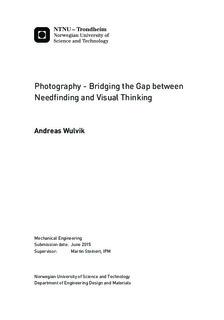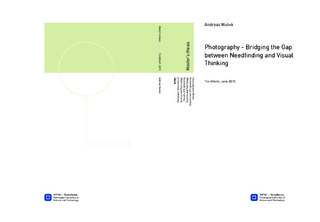| dc.description.abstract | Founding on the pre-master project Photography a new tool in needfinding (Wulvik et al., 2015) as starting point and based on theory from the fields of needfinding and visual thinking, an explorative experiment has been piloted, run and analysed. The goal of the experiment was to test the influence of focal length and depth of field on the verbal ideation output from designers tasked with improving situations shown in pictures. Output was measured by: number of insights, solutions, questions and the total sum of these. Focal length and depth of field were given two values each, pushing towards extremes in both directions. Focal length was given the values of 24mm (wide-angle) and 100mm (telephoto). Depth of field is mostly controlled by aperture, and apertures of f/2.8 and f/16 (f/11) were used to create small and large depth of field. Four different situations were photographed with all four combinations of the focal length and depth of field (24mm & f/2.8, 24mm & f/11, 100mm & f/2.8, 100mm & f/16), a total of 16 pictures to be used as stimuli in the experiment. To get as much data as possible from the participants, each was shown four pictures, one from each situation and paired with different variable combinations. 18 participants were a part of the final experiment, each looking at four pictures. A total of 72 data points were collected.
Data was collected through audio recording and eye tracking. Each participant was placed in front of a monitor with an eye tracker placed underneath and given a hand-held microphone. During the experiment, the participant was asked to think out loud so that their thoughts could be captured with audio. The eye tracker captured their gaze position. After the experiment, audio data was coded into insights, solutions and questions based on an emergent coding scheme. Even though eye-tracking data was recorded, it was not finally used for the results of this pilot experiment due to difficulties with interpreting gaze data. Eye tracking technology and knowledge is rapidly improving, so if any breakthroughs in analysis should occur in the near future, data is stored and available for analysis.
No statistically significant results were found when running independent samples t-tests for focal length and depth of field. However, though not statistically significant, an indication towards the effect of increased output of solutions when using a longer focal length was found with a calculated significance value 0.894. This potential difference is corresponds with initial hypothesis H1: Longer focal lengths provide more output because more equal attention is given to visual elements.
Based on results from and identified error sources in this pilot experiment, areas of improvement for a second experiment have been proposed and are currently put into place. | |

